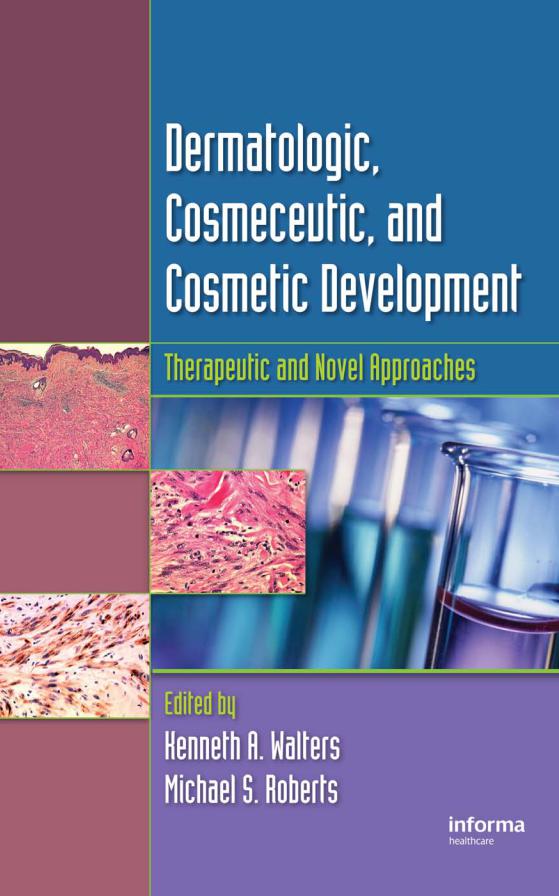
- •Preface
- •Contributors
- •Introduction
- •Part I: Skin Disorders and Therapies
- •Part II: Specific Factors Affecting Targeting and Efficacy
- •Part III: Topical Pharmaceuticals, Formulations, and Indications
- •Part IV: Topical Cosmeceuticals, Formulations, and Indications
- •Part V: Safety Considerations
- •Part VI: Skin Assessment


Dermatologic,
Cosmeceutic, and
Cosmetic Development

Dermatologic,
Cosmeceutic, and
Cosmetic Development
Therapeutic and Novel Approaches
Edited by
Kenneth A. Walters
An-eX Analytical Services Ltd.
Cardiff, United Kingdom
Michael S. Roberts
School of Medicine, University of Queensland
Princess Alexandra Hospital
Buranda, Australia

Informa Healthcare USA, Inc. 52 Vanderbilt Avenue
New York, NY 10017
© 2008 by Informa Healthcare USA, Inc. Informa Healthcare is an Informa business
No claim to original U.S. Government works
Printed in the United States of America on acid-free paper 10 9 8 7 6 5 4 3 2 1
International Standard Book Number-10: 0-8493-7589-4 (hb : alk. paper) International Standard Book Number-13: 978-0-8493-7589-7 (hb : alk. paper)
This book contains information obtained from authentic and highly regarded sources. Reprinted material is quoted with permission, and sources are indicated. A wide variety of references are listed. Reasonable efforts have been made to publish reliable data and information, but the author and the publisher cannot assume responsibility for the validity of all materials or for the consequence of their use.
No part of this book may be reprinted, reproduced, transmitted, or utilized in any form by any electronic, mechanical, or other means, now known or hereafter invented, including photocopying, microfilming, and recording, or in any information storage or retrieval system, without written permission from the publishers.
For permission to photocopy or use material electronically from this work, please access www.copyright.com (http://www.copyright.com/) or contact the Copyright Clearance Center, Inc. (CCC) 222 Rosewood Drive, Danvers, MA 01923, 978-750-8400. CCC is a not-for-profit organization that provides licenses and registration for a variety of users. For organizations that have been granted a photocopy license by the CCC, a separate system of payment has been arranged.
Trademark Notice: Product or corporate names may be trademarks or registered trademarks, and are used only for identification and explanation without intent to infringe.
Library of Congress Cataloging-in-Publication Data
Dermatologic, Cosmeceutic, and Cosmetic Development: Therapeutic and Novel Approaches / edited by Kenneth A. Walters, Michael S. Roberts.
p. ; cm.
Includes bibliographical references and index.
ISBN-13: 978-0-8493-7589-7 (hb : alk. paper)
ISBN-10: 0-8493-7589-4 (hb : alk. paper)
1. Skin—Diseases—Chemotherapy. 2. Dermatopharmacology. 3. Cosmetics—Side effects. I. Walters, Kenneth A., 1949II. Roberts, Michael S., 1949-
[DNLM: 1. Skin Diseases—drug therapy. 2. Administration, Cutaneous.
3. |
Cosmetics—adverse effects. 4. Cosmetics—pharmacokinetics. 5. |
|
Dermatologic Agents—adverse effects. 6. Dermatologic |
|
|
Agents—pharmacokinetics. 7. Skin Absorption. WR 650 D4355 2007] |
|
|
|
RL801.D473 2007 |
|
|
616.5'061—dc22 |
2007031863 |
For Corporate Sales and Reprint Permissions call 212-520-2700 or write to:
Sales Department, 52 Vanderbilt, 16th floor, New York, NY 10017.
Visit the Informa Web site at www.informa.com
and the Informa Healthcare Web site at www.informahealthcare.com


Preface
Skin disorders can be both physically and psychologically traumatic for the patient. Reactions can range from the extreme discomfort of infantile eczema to the painful embarrassment of teenage acne to the midlife desire to reduce facial wrinkles and hyperpigmentation. Researchers and clinicians within the pharmaceutical and cosmetic industriesstrivetofindthosetreatmentsthatwillsuccessfullyalleviatethedistressing symptoms. Basic researchers are continually searching for causative factors, be they immunologically, genetically, or environmentally mediated. As this research con- tinues, it is safe to say that there have been many recent, significant advances in our understanding of the development and morphology of normal skin, and this has led to a more reliable ability to deliver therapeutic compounds to selected targeted areas both within the skin and systemically.
This book provides an overview of the current pharmaceutical and cosmeceutical practices in the management of both major and minor skin disorders. It is divided into eight parts. The first section is concerned with specific factors affecting efficacy of topical therapy and includes an overview of the range of skin disorders, drugs used to manage these disorders, sites where an effect is sought, and how per- cutaneous absorption is affected by age, skin site, race, and skin disease or damage.
This section also considers delivery to the systemic circulation, appendages, and nails. The second section discusses pharmaceutical therapy from the viewpoint of topical absorption and covers treatment of the major skin diseases and injuries such as wounds and burns, with particular emphasis on novel approaches.
The third section introduces the underlying principles defining cosmeceuti- cals and goes on to examine their applications, sources, and formulations. The skin absorption and use of specific cosmeceuticals are then considered, covering both cosmeceutical and cosmetic agents such as hair dyes, sunscreens, oils, hydroxyacids, moisturizers, and insect repellents. The next section includes an evaluation of the evidence base for cosmeceuticals, their appropriate use, and the safety and toxicity issues.
The final portion of the book is concerned with improving therapeutic out- comes. The various methods used to improve drug transport into and across the skin, including more accurate dosing regimens, chemical penetration enhancers, physical enhancement, and the use of microneedles and high impact powder, or biolistic, delivery.
This book has been written for scientists interested in dermatological ther- apy and those concerned with the marketing of pharmaceutical and cosmeceutical products; in addition, it will prove useful to students and those involved in research and development in the pharmaceutical and cosmetic industries.
We have been fortunate to obtain the agreement of many internationally rec- ognized experts in the field of dermal pharmaceutics and cosmeceuticals to provide coverage of their specific fields of expertise. To all of our authors we extend our sincere thanks for their unreserved efforts and time.
Kenneth A. Walters
Michael S. Roberts
iii


Contents
Preface . . . . iii
Contributors . . . . viii
Introduction
1. Skin Structure, Pharmaceuticals, Cosmetics, and the Efficacy
of Topically Applied Agents 1
Michael S. Roberts and Kenneth A. Walters
Part I: Skin Disorders and Therapies
2. Drugs Used for Skin Diseases 11
Neil Kitson
3. Treatment of Dermatitis 21
Chris Anderson
4. Evolution of Cosmeceuticals and Their Application to Skin Disorders, Including Aging and Blemishes 45
Des Fernandes
5. Biology of Skin Pigmentation and Cosmetic Skin Color Control 61
Chong Jin Loy and Raman Govindarajan
6. Evidence-Based Cosmeceutical Therapy 97
Maria Miteva and Joachim W. Fluhr
Part II: Specific Factors Affecting Targeting and Efficacy
7. Skin Hydration—A Key Determinant in Topical Absorption 115
Michael S. Roberts, Joke Bouwstra, Fabrice Pirot, and Françoise Falson
8. Epidemiology of Skin Barrier Function: Host and Environmental Factors 129
Greg G. Hillebrand and R. Randall Wickett
9. Permeability Through Diseased and Damaged Skin 157
Daniel A. W. Bucks
10. Targeting the Pilosebaceous Gland 169
Guang Wei Lu, Susan Ciotti, Satyanarayana Valiveti, Jeffrey E. Grice, and Sheree E. Cross
11. Drug Penetration Enhancement Through Human Nail and Skin 189
Thomas C. K. Chan, Kenneth A. Walters, Xiaoying Hui, and Howard I. Maibach

vi Contents
Part III: Topical Pharmaceuticals, Formulations, and Indications
12. Getting the Dose Right in Dermatological Therapy 197
Adrian F. Davis
13. Drugs for Pain and Inflammation 215
Michael W. Whitehouse, Mantu Sarkar, and Michael S. Roberts
14. Novel Topically Active Antimicrobial/Anti-inflammatory Compounds for Acne 243
Joseph A. Dunn, Robert A. Coburn, Richard T. Evans, Robert J. Genco, and
Kenneth A. Walters
15. Codrugs: Potential Therapies for Dermatological Diseases 255
Tadeusz Cynkowski, Grazyna Cynkowska, and Kenneth A. Walters
16. Topical Therapeutic Agents Used in Wound Care 267
Sheree E. Cross
17. Established and Emerging Oral Antifungals in Dermatology 283
Gérald E. Piérard, Claudine Piérard-Franchimont, Valérie Vroome, Jorge Arrese,
Pascale Quatresooz, Marcel Borgers, and Geert Cauwenbergh
18. Hydroxy Acids and Retinoids in Cosmetic Products 297
Robert L. Bronaugh
Part IV: Topical Cosmeceuticals, Formulations, and Indications
19. Natural Ingredients Used in Cosmeceuticals 303
Anthony C. Dweck |
|
20. Influence of Formulation Design on the Clinical Performance |
|
of Topically Applied Formulations 325 |
|
Johann W. Wiechers |
|
21. Dry Skin and Moisturizers 339 |
|
Anthony Vincent Rawlings and Paul John Matts |
|
22. Antioxidants in the Skin: Dermatological and Cosmeceutical Aspects |
373 |
Maxim Darvin and Juergen Lademann |
|
23. Absorption and Evaporation of Volatile Compounds Applied to Skin |
385 |
Gerald B. Kasting, Matthew A. Miller, and Johannes M. Nitsche |
|
24. Efficacy, Absorption, and Safety of Essential Oils 401
Ulrich F. Schäfer, Jürgen Schneele, Sonja Schmitt, and Jürgen Reichling
25. Sunscreens: Efficacy, Skin Penetration, and Toxicological Aspects 419
Heather A. E. Benson

Contents vii
Part V: Safety Considerations
26. Efficacy and Safety of Tea Tree and Other Oils 437
Christine F. Carson, Kate A. Hammer, and Jesper B. Nielsen
27. Safety Assessments Based on Exposure, Skin Permeation and Toxicity Considerations 453
William E. Dressler and Kenneth A. Walters
Part VI: Skin Assessment
28. Noninvasive Evaluation of Skin in the Cosmetic Industry 467
Carlos Galzote, Michael Suero, and Raman Govindarajan
29. Application of In Vivo Scanning Microscopy for Skin Analysis in Dermatology and Cosmetology 487
Lars E. Meyer and Juergen Lademann
Part VII: Improving Therapeutic Outcomes Using Chemical Techniques
30. Chemical Penetration Enhancement: Possibilities and Problems 497
Adrian C. Williams and Kenneth A. Walters
31. Multicomponent Formulations of Chemical Penetration Enhancers 505
Pankaj Karande, Amit Jain, and Samir Mitragotri
Part VIII: Improving Therapeutic Outcomes Using Physical Techniques
32. Iontophoresis 517
Narayanasamy Kanikkannan, Michael Bonner, Jagdish Singh, and Michael S. Roberts
33. DNA Transfer in the Skin 537
Gaëlle Vandermeulen, Liévin Daugimont, and Véronique Préat
34. Pressure Waves for Transdermal Drug Delivery 557
Apostolos G. Doukas, Sumit Paliwal, and Samir Mitragotri
35. Microneedle Arrays as Transcutaneous Delivery Devices 577
James Birchall and Keith R. Brain
36. Needle-Free Ballistic Delivery of Powdered Immunotherapeutics to the Skin Using Supersonic Gas Flow 591
Mark A. F. Kendall
